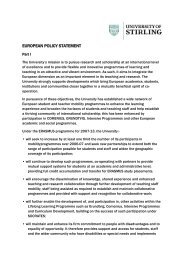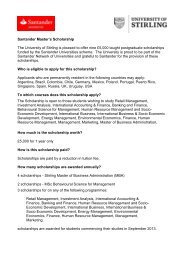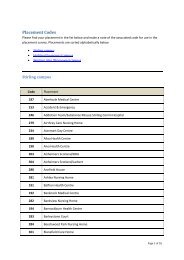Health First: An evidence-based alcohol strategy for the UK
Health First: An evidence-based alcohol strategy for the UK
Health First: An evidence-based alcohol strategy for the UK
You also want an ePaper? Increase the reach of your titles
YUMPU automatically turns print PDFs into web optimized ePapers that Google loves.
<strong>Health</strong> <strong>First</strong>: an <strong>evidence</strong>-<strong>based</strong> <strong>alcohol</strong> <strong>strategy</strong> <strong>for</strong> <strong>the</strong> <strong>UK</strong><br />
significant mental health issue within <strong>the</strong> population,<br />
affecting 4% of people aged between 16 and 65 in<br />
England (6% of men and 2% of women) 16 .<br />
The physical and psychological risks of <strong>alcohol</strong><br />
consumption are much greater <strong>for</strong> children and young<br />
people than <strong>the</strong>y are <strong>for</strong> adults. In <strong>the</strong> <strong>UK</strong>, levels of<br />
drinking among 15-year-olds are significantly higher<br />
than <strong>the</strong> European average 17 . Currently early drinking<br />
uptake appears to be most common in Wales where<br />
high rates of drinking are already established among<br />
13-year-olds (Figure 2.4).<br />
The overall impact of <strong>alcohol</strong> on deaths, illness and<br />
disability is described by <strong>the</strong> number of lost ‘disabilityadjusted<br />
life years’ in <strong>the</strong> population as a whole.<br />
According to <strong>the</strong> World <strong>Health</strong> Organisation, <strong>alcohol</strong><br />
accounts <strong>for</strong> 9.2% of all <strong>the</strong> lost disability-adjusted life<br />
years in developed countries such as <strong>the</strong> <strong>UK</strong>, with most<br />
of <strong>the</strong>se years lost due to mental health conditions and<br />
unintentional injuries such as road traffic accidents,<br />
burns, drowning and falls 18 . Whichever way <strong>the</strong><br />
statistics are calculated, <strong>the</strong> conclusion is inescapable:<br />
<strong>the</strong> damage caused by <strong>alcohol</strong> to <strong>the</strong> health and<br />
wellbeing of individual drinkers is immense.<br />
Impacts on children, families and<br />
communities<br />
Beyond <strong>the</strong> direct effects of <strong>alcohol</strong> on <strong>the</strong> health<br />
and wellbeing of individual drinkers, <strong>the</strong>re are many<br />
adverse impacts of <strong>alcohol</strong> on children, families,<br />
households, communities and <strong>the</strong> national economy.<br />
Within <strong>the</strong> home, domestic violence is all too often<br />
linked to drinking. In England and Wales in 2009/10,<br />
37% of <strong>the</strong> victims of domestic violence perceived<br />
<strong>the</strong>ir attackers to have been under <strong>the</strong> influence of<br />
<strong>alcohol</strong> 19 , and a Home Office study of male domestic<br />
violence offenders in England found that 49% had a<br />
history of <strong>alcohol</strong> abuse 20 .<br />
Children are especially vulnerable to violence and<br />
<strong>the</strong> wider effects of <strong>alcohol</strong> in <strong>the</strong> home. In 2008/09,<br />
a fifth (21%) of all young callers to Childline were<br />
worried about drinking by a parent or o<strong>the</strong>r significant<br />
person 21 . They described experiences of neglect,<br />
violence, isolation and fear.<br />
Millions of children are at risk: in Britain, an estimated<br />
3.4 million children live with at least one parent who<br />
binge drinks 22 and, in England, an estimated 79,291<br />
babies under one year old live with a parent who is a<br />
problem drinker 23 .<br />
Recent research into <strong>the</strong> drinking behaviour of new<br />
parents found that, after <strong>the</strong> birth of <strong>the</strong>ir first child,<br />
23% of parents continued to drink as much as be<strong>for</strong>e<br />
<strong>the</strong>ir baby was born and 17% increased <strong>the</strong> amount<br />
<strong>the</strong>y consumed. Overall, around three in ten parents<br />
drank more than <strong>the</strong> recommended units per week 24 .<br />
Babies are at greater risk of dying suddenly and<br />
unexpectedly if <strong>the</strong>ir parents drink more than two<br />
units of <strong>alcohol</strong> be<strong>for</strong>e sleeping with <strong>the</strong>m in a bed or<br />
on a sofa 25 .<br />
Both within and beyond <strong>the</strong> home, <strong>alcohol</strong> plays<br />
a central role in driving violence. In 2010/11, 44%<br />
of all violent incidents in England and Wales were<br />
committed by people who had been drinking 26 . That<br />
amounts to 928,000 <strong>alcohol</strong>-related violent incidents<br />
in a single year. Although <strong>the</strong> number of violent crimes<br />
in England and Wales has fallen over <strong>the</strong> last 15 years,<br />
<strong>the</strong> proportion committed under <strong>the</strong> influence of<br />
<strong>alcohol</strong> has not (Figure 2.5).<br />
The economic cost of <strong>alcohol</strong> is difficult to quantify as<br />
no data are routinely collected. However each of <strong>the</strong><br />
harms described above has a significant economic<br />
impact. Public services that bear <strong>the</strong> costs of <strong>alcohol</strong><br />
include <strong>the</strong> NHS, local government, <strong>the</strong> police, <strong>the</strong><br />
Figure 2.4 Weekly drinking by 13-year-olds and<br />
15-year-olds in Great Britain, 2009/10 (WHO)<br />
aweek<br />
eastonce<br />
coholatle<br />
odrinkalc<br />
%who<br />
Figure 2.5 Violent crimes and <strong>the</strong> role of <strong>alcohol</strong>:<br />
England and Wales 2005 – 2011 (British Crime Survey)<br />
00s)<br />
imes(1,00<br />
violentcri<br />
umberofv<br />
Nu<br />
40%<br />
35%<br />
30%<br />
25%<br />
20%<br />
15%<br />
10%<br />
5%<br />
0%<br />
4500<br />
4000<br />
3500<br />
3000<br />
2500<br />
2000<br />
1500<br />
1000<br />
500<br />
0<br />
boys<br />
numberofviolentcrimes(000s)<br />
girls<br />
Europe England Scotland Wales Europe England Scotland Wales<br />
13yearolds<br />
15yearolds<br />
%underinfluenceof<strong>alcohol</strong><br />
60%<br />
50%<br />
40%<br />
30%<br />
20%<br />
10%<br />
0%<br />
lcohol<br />
enceofal<br />
nderinflue<br />
portionun<br />
Prop<br />
15
















